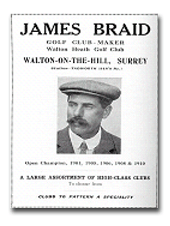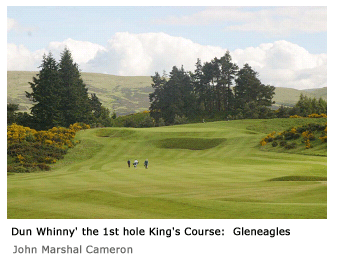|
| |
|
present day craze for length would receive a nasty set-back with the
larger ball. That, in itself, might be a good thing, but I cannot
imagine it being a popular innovation”. It was fifteen years before the 1.68" ball was given a trial run in British PGA tournaments and it was finally adopted in the seventies. Now, sixty years after Henry’s book was published, the ball gets ever longer and courses are still being altered in an attempt to control the dominance of the big hitters. When the first batches of balls came off the production lines after the war they were strictly rationed and you had to apply to the manufacturers stating that they were required for a special competition, giving the number of players involved. You were allowed one ball per player. We arranged quite a few special events as the club trophies emerged from wartime storage. I stayed on at Brancepeth until 1951, serving as part time pro, but remaining with the Civil Service. I had decided by then that they offered me a better chance to make a steady income for our family and get a pension; golf did not have the prospects for seniors that exist today. My appearances in major events were few and far between after the war, as I had to use my annual leave in odd days to fit in with competition dates. The Civil Service was not over generous with leave allowances, but I could take a limited number of half-days and these I utilised mainly for local PGA and Alliance meetings. I could generally manage only one or two major events per year. I made only three more appearances in the Open and went on one last nostalgic trip to the Irish Open.  “GOLF BEGINS AGAIN”, headlined the Times in July, 1945 and announced
that the V. E.’ News of the World Matchplay Championship would take
place that month at its traditional home-Walton Heath. The final was
contested between two of the neatest players and sweetest strikers
of the day, Reg Horne and Percy Alliss, with Reg emerging the
winner. I did not go that year and my next match in the event was to
be in 1949 when I came up against Dai Rees again and this time he
beat me. It was at Walton Heath that I had met another member of the
Great Triumvirate before the war, when I played in the News of the
World in 1938. Five times Open champion James Braid, a founder
member and first Captain of the PGA, was appointed professional when
the club opened in 1904 and had nearly completed his forty-five
years at Walton Heath when I met him again in 1949. It was said that
he swung the club with “divine fury” in contrast to his “perfect
placidity” as Bernard Darwin put it, - on and off the course. He was
a man of few words but commanded great respect. “Nobody could be so
wise as James Braid looks” was a very apt description and that is
how I remember the elder statesmen of our profession. His shop was a
‘tin hut’ described by Darwin as “highly unpretentious and rather
dark” and he told a story about a visiting American who went into
the shop where Braid was at work and asked if he would like a game.
“—Braid, with his habitual Scottish charm, agreed”, wrote Darwin.
“Two and a half hours later the American was heard to say: ‘Gee!
That guy in your wood shack is a promising player’” The Captaincy of
the PGA, which had been vacant during the war, was bestowed on him
for the sixth time in 1946 – a measure of the esteem in which he was
held. “GOLF BEGINS AGAIN”, headlined the Times in July, 1945 and announced
that the V. E.’ News of the World Matchplay Championship would take
place that month at its traditional home-Walton Heath. The final was
contested between two of the neatest players and sweetest strikers
of the day, Reg Horne and Percy Alliss, with Reg emerging the
winner. I did not go that year and my next match in the event was to
be in 1949 when I came up against Dai Rees again and this time he
beat me. It was at Walton Heath that I had met another member of the
Great Triumvirate before the war, when I played in the News of the
World in 1938. Five times Open champion James Braid, a founder
member and first Captain of the PGA, was appointed professional when
the club opened in 1904 and had nearly completed his forty-five
years at Walton Heath when I met him again in 1949. It was said that
he swung the club with “divine fury” in contrast to his “perfect
placidity” as Bernard Darwin put it, - on and off the course. He was
a man of few words but commanded great respect. “Nobody could be so
wise as James Braid looks” was a very apt description and that is
how I remember the elder statesmen of our profession. His shop was a
‘tin hut’ described by Darwin as “highly unpretentious and rather
dark” and he told a story about a visiting American who went into
the shop where Braid was at work and asked if he would like a game.
“—Braid, with his habitual Scottish charm, agreed”, wrote Darwin.
“Two and a half hours later the American was heard to say: ‘Gee!
That guy in your wood shack is a promising player’” The Captaincy of
the PGA, which had been vacant during the war, was bestowed on him
for the sixth time in 1946 – a measure of the esteem in which he was
held. Braid was a prolific and highly rated architect and his superb
courses at Gleneagles are perhaps the most famous of his designs. A
column in the American Golfer of 1928 said: “---- no keen golfer’s
education is quite complete – if it ever is! – until he has played
upon the King’s course and the Queen’s course at Gleneagles----”. It
went on, “You may play a good round or a bad; bad if you are
temperamental and ‘subject to scenery’; good if you can steel your
eyes and your hand to the business of the moment, which is to do
justice to these grand golfing holes, and to the card that allows
you 80 of a score”. I remember that they did have a special score
card when I played there in the thirties, with a bogey (par) of 80
for the benefit of visitors-particularly Americans, who liked to say
that they had beaten bogey; the 360-yard first hole had a bogey of
five. No such luxury for the professionals, but the King’s was a
particular favourite of mine – it reminded me of Brancepeth Castle. Braid was a prolific and highly rated architect and his superb
courses at Gleneagles are perhaps the most famous of his designs. A
column in the American Golfer of 1928 said: “---- no keen golfer’s
education is quite complete – if it ever is! – until he has played
upon the King’s course and the Queen’s course at Gleneagles----”. It
went on, “You may play a good round or a bad; bad if you are
temperamental and ‘subject to scenery’; good if you can steel your
eyes and your hand to the business of the moment, which is to do
justice to these grand golfing holes, and to the card that allows
you 80 of a score”. I remember that they did have a special score
card when I played there in the thirties, with a bogey (par) of 80
for the benefit of visitors-particularly Americans, who liked to say
that they had beaten bogey; the 360-yard first hole had a bogey of
five. No such luxury for the professionals, but the King’s was a
particular favourite of mine – it reminded me of Brancepeth Castle.Other newspaper proprietors came forward to sponsor events; the News Chronicle and Star each put up £3000 to get the show back on the road and the Daily Sketch sponsored a four-ball competition. The |
